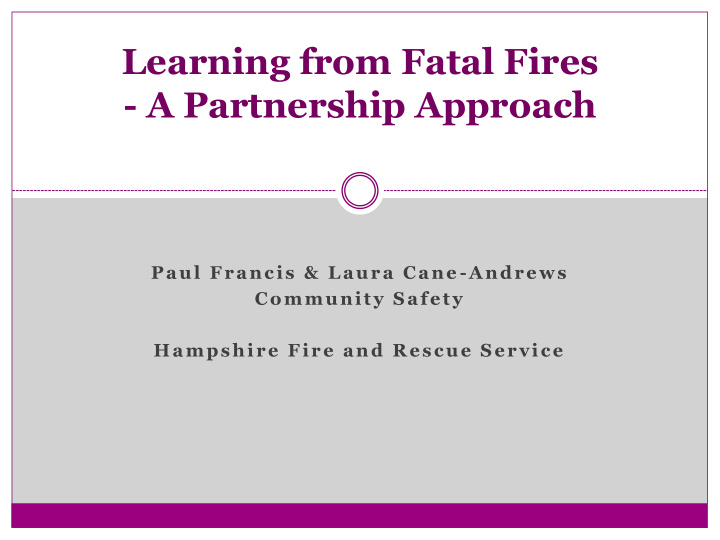



Learning from Fatal Fires - A Partnership Approach Paul Francis & Laura Cane -Andrews Community Safety Hampshire Fire and Rescue Service
Impact of fire deaths Responsibility of all agencies to promote Impact on local services in terms of wellbeing, safety, prevention and early resources for investigation/housing/on- intervention going care and support Preventable and foreseeable Risks to neighbours, family members, deaths/serious injuries care agencies, responders, wider public, etc. Traumatic, sudden events Reputational risk to agencies where harm is foreseeable Huge emotional impact on the individual, their families and professionals Leads significant deterioration in wellbeing and quality of life post incident
Analysis of Hampshire Fire Deaths 2015/18 26 cases of death/serious injury 11 fatalities for all Hampshire 4 cases resulting in serious/life 21 cases in the HSAB area changing injury HFRS worked with Portsmouth, 15 cases all had care and support Southampton & IOW LSAB needs with long term care and support in place 5 people were not known to the local authority All 15 cases were reviewed against a standardised audit tool 1 death was not as a result of a fire
General risk factors identified Environment: Behaviour: Physical/mental health: Identifiable ignition Smoking Poor mental health sources ( e.g. candles, angle grinder, blow torch, cooker Alcohol/drug use Age/frailty matches, petrol cigarette, methylated spirit, electric Hoarding Poor mobility fire ) Self Neglect Dementia Fire alarm absent or not working Fire setting Hoarding Lived alone
Trends and themes Age/frailty : 60% of cases 66 years+ (47% Fire safety referral : long term care and were 76 years+). support was in place in all cases, but a referral was made in only 33% of cases. Gender: 67% of victims were male Safe and Well visits: carried out in only 3 cases (in 2 other cases 1 refusal and 1 Mental health : a factor in 47% of cases unable to contact) (includes 2 incidents of self immolation) Risk factors : 60% identifiable ignition Services: in 60% of cases the adult was in sources, 53% smoking, hoarding/self receipt of domiciliary care neglect 14% cases (but all Hants 23%) Residence : in 67% of cases the fire Learning and review : 9 cases referred occurred in the person’s own home. for a MAR but only 3 reviews (33%) were undertaken – low conversion rate Location : occurrences evenly spread across all Districts
Key learning and next steps Analysis and response for all Awareness training to increase Hampshire and IOW referrals to HFRS for Safe and Well visit Fire safety and prevention needs to be an integral part of the Use of the Multi-Agency Risk support offered by partners in Management process to manage particular, domiciliary care on-going risk providers 4LSAB Fire Safety Group to lead Guidance needed on signs and and coordinate the response indicators of fire safety risk, guidance relating specifically Multi-Agency Hoarding Guidance to ignition sources, smoking Improved review of serious injuries Targeted work in mental health as a result of fire services
S.A.L Considerations Support the work of HFRS & HSAB partners by ensuring fire safety is fully embedded within all risk management processes Adopt a person centred fire risk assessment in order to manage an individuals vulnerability to fire Consider the fire risk factors (environment, behaviour, physical/mental health) for all service users Ensure the MARM process is fully explored in relation to fire safety, with HFRS as a key partner
S.A.L Considerations For individuals who are presenting vulnerabilities towards fire: Referrals to HFRS for Safe And Well interventions Communicate with local HFRS Community Safety Officers regarding known risk Engage with HFRS Community Safety Officers to provide bespoke training and informal staff briefings at your team meetings.
Any comments or questions?
Recommend
More recommend